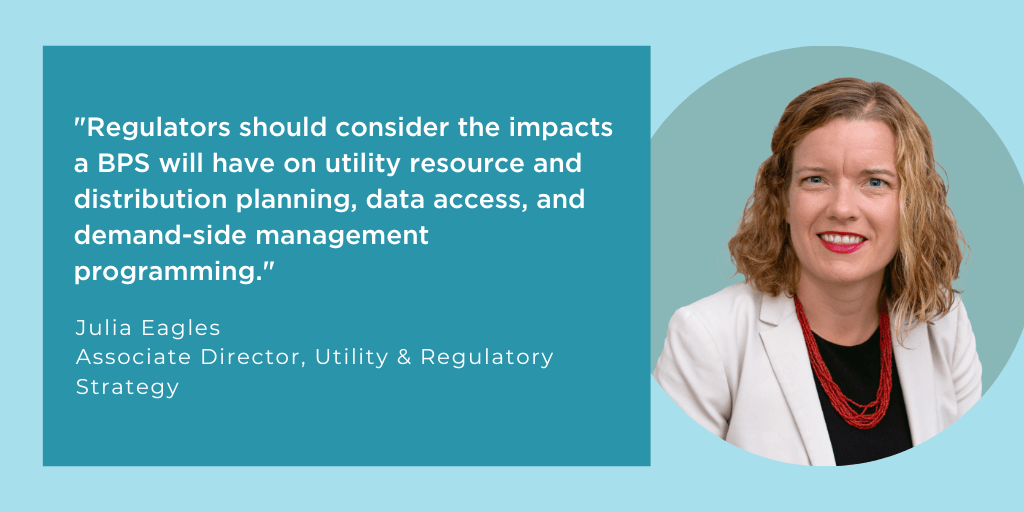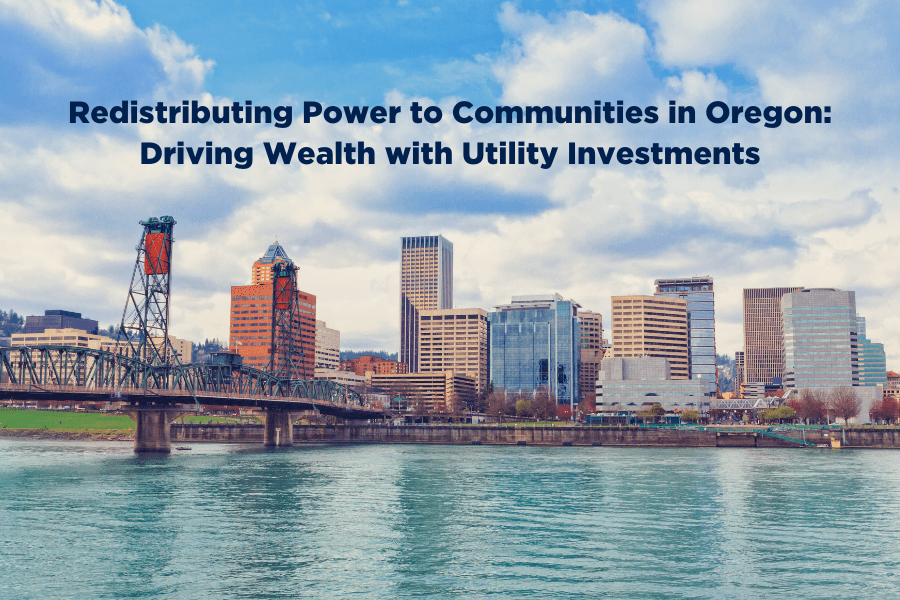How Building Decarbonization Policies will Impact Utilities, the Grid, and Planning
This article first appeared in Public Utilities Fortnightly.
Why should I care about Building Performance Standards?
A growing number of state and local governments are adopting a new policy called Building Performance Standards (BPS) that has the potential to significantly reduce energy, carbon, and water use in existing buildings. Let’s dive into how BPS works—what regulators need to know and how the BPS in Washington State is already impacting the buildings market.

What are Building Performance Standards?
Building performance standards are powerful, flexible policies that require large buildings – and primarily commercial and multifamily – to meet specified levels of performance that grow more rigorous over time. It does not prescribe how the performance requirement will be met, leaving it to owners to determine the most cost-effective strategy for their particular building.
Jurisdictions may choose to create standards around energy use, carbon emissions, water use, or other areas that reflect their broader climate, energy, or social goals. By mandating meaningful improvements to a large portion of a jurisdiction’s building stock, a BPS can drive significant change.
For example, preliminary analysis of DC’s Building Energy Performance Standard (packaged under the Clean Energy Omnibus Amendment Act of 2018) suggests the policy may save around twenty percent of the District’s total energy use by 2032. Analysis of New York City’s Local Law 97 (LL97) suggests that the policy requires a forty percent reduction in citywide emissions and could drive up to twenty billion dollars of investment by 2030.

Building Performance Standards (BPS)
This collection of resources combines all of IMT’s existing guidance on building performance standards.
View this collectionBPS momentum is growing
As of March 2023, there are eleven BPS policies in place across the United States covering roughly 9.5 billion square feet of building space and twenty-four million people.

This already large footprint is poised to grow dramatically over the next few years. In January 2022, President Biden and the White House announced the National Building Performance Standards Coalition, which is a group of more than forty cities, counties, and state governments committed to passing community-driven, holistic building performance policies by April 2024 that would cover more than twenty-one billion square feet of building space and seventy-four million people.
Regulators, BPS, and Grid Impacts
All utility regulators have a statutory duty to ensure customers receive reliable, safe, and affordable services from their utilities. Some state legislatures, like Colorado and Maine, have gone further and expanded their regulators’ authority to include meeting climate and equity goals. In all cases, regulators should consider the impacts a BPS will have on utility resource and distribution planning, data access, and demand-side management programming.
By changing how much and when large buildings consume energy, a building performance standard will directly impact utility planning. Utility regulators should therefore require utilities to account for BPS in their modeling.
Utilities must consider the impact of BPS in their resource and distribution planning
Integrated Resource Planning (IRP) analyzes how utilities can meet forecasted demand over a specified planning period; and Distribution System Planning (DSP) or Integrated Distribution Planning (IDP) analyzes how utilities need to invest in distribution infrastructure to deliver energy to customers as demand changes over time.
Both of these planning processes are rooted in response to ratepayers’ demand for energy and exist to ensure that utilities make prudent investments. By changing how much and when large buildings consume energy, a BPS will directly impact utility planning. Utility regulators should, therefore, require utilities to account for BPS in their modeling.
As an example, New York City’s LL97 has a strong focus on electrification. The Urban Green Council’s Grid Ready report found that New York City’s BPS will cause electrification to increase peak demand, principally by increasing winter peaks. Affected utilities will need to account for the impacts of LL97 in their resource and distribution system planning and programming to ensure that they provide the most cost-effective service.
Utility programs can support their customers and ensure grid benefits
Grid-edge, customer-sited technologies such as solar, storage, and demand flexibility mean that the old paradigm of a one-way flow of power from generating assets to customers is no longer valid. Utilities and regulators across the country are increasingly acknowledging this transition by developing programs to increase the efficiency and flexibility of customer power demand to benefit the grid.
As jurisdictions implement BPS, buildings may be phased in depending on their square footage or classification. It’s crucial that utility providers work alongside building owners and customers to continue providing reliable service as energy efficiency standards improve.
As an example, both Pepco and the D.C. Sustainable Energy Utility (DCSEU) are planning programs to support D.C.’s Building Energy Performance Standard. Over the next five years, DCSEU is investing more than fifty million in an Affordable Housing Retrofit Accelerator program to ensure affordable multifamily building owners and managers have access to the technical, contractor, and financial resources they will need to improve their buildings’ performance and comply with DC’s building performance standard.

Case study: Washington State’s Clean Buildings Performance Standard
Washington became the first state to create a statewide BPS in 2019 when the legislature passed the Clean Buildings Law (HB 1257). The Clean Buildings Performance Standard (CBPS):
- Created benchmarking and performance requirements for non-residential commercial buildings larger than fifty thousand square feet;
- Designated the Department of Commerce (Commerce) to administer the law, and;
- Created a seventy-five million State-administered Early Adopter Incentive Program (EAIP) to facilitate early adoption, especially for the highest energy using buildings.
In 2022, the law was expanded (SB 5722) to phase in all commercial and multifamily buildings over twenty thousand square feet, for benchmarking and energy management requirements, and increase funding for the EAIP to two hundred twenty-five million for these additional buildings.
One of the initial benefits of the CBPS has been increased communication among utilities and state agencies. Following passage of the CBPS, Commerce reached out to key staff at the state’s utilities and provided a briefing.
Acknowledging the importance of such a policy, several utility staff dedicated significant time to participate in the rulemaking process to ensure that it took into account utility considerations. Even after the rulemaking was completed, a group of staff from several utilities across the state has continued to meet with Commerce on a monthly basis. Utilities also helped by connecting with building owners, occupants, and property managers to increase awareness about the law, and encourage engagement with Commerce to understand the CPBS.
The value of communication between Commerce and the utilities was particularly clear in the case of whole-building data access. Commerce presumed that utility metering infrastructure has energy data delineated by individual buildings. However, most utility metering systems are customer and account centric, and the building boundary can be complex to define from a metering perspective for many types of buildings.
For example, a multifamily building may have multiple meters and customer accounts under a single building, raising privacy concerns if individual data were shared with a non-utility customer property owner. Or multiple buildings may be served by a single meter, such as on a college campus or at a shopping mall that may have dozens of meters covering multiple buildings.
The City of Seattle has navigated these challenges and has been providing whole-building or campus-level benchmarking data since 2012 in response to Seattle’s benchmarking ordinance. But it has been a challenge for the state’s other utility providers.
While there is an existing state law requiring energy consumption data disclosure by utilities, the CBPS did not codify a formal method to coordinate data access and sharing between Commerce, utilities, and building owners. A public facing system of record that clearly identifies building owner(s), their various buildings and building areas plus locations, building owner contact info, and (ideally) the utility(ies) that serves that building would have greatly improved coordination and outreach efforts in Washington.
Additional complexities in leased commercial space are diverging interests between building owners and occupants known as the split incentive. In many buildings, the building owner is not a building occupant, may not be a utility customer, and may not have financial incentive to improve building energy performance.
By holding building owners accountable, this law is a useful tool in addressing the split incentive issue, which is a long-standing challenge in energy conservation. However, utilities are customer focused, and the CBPS requires utilities to engage with a new audience, such as non-customer building owners.
This can be challenging, as determining and managing to whom utilities are obligated to provide energy data is difficult while observing state-mandated customer privacy requirements. Commerce has been working with the utilities and industry stakeholders to address these challenges, and the tone has been constructive and collaborative.
Washington’s EAIP pays eighty-five cents per square foot to participating building owners; utilities can recover the cost via a reduction in owed taxes. There are different tax credits available depending if the recipient is a public utility vs. an investor-owned utility. This structure keeps EAIP separate from existing utility conservation programs and aims to catalyze owners to improve their buildings’ performance prior to the CBPS deadlines.
A separate piece of legislation, the Clean Energy Transformation Act, requires all electric utilities serving retail customers in Washington to supply electricity free of greenhouse gas emissions by 2045.
It also requires the equitable distribution of energy benefits and reduction of burdens to vulnerable populations. To execute these dual requirements, Commerce decided, with stakeholder input, to commit half of the EAIP funding to improve buildings that are the highest energy users, are located in rural areas, and provide affordable multifamily housing. By thinking creatively about the EAIP, Commerce was able to simultaneously address both climate and equity goals.

